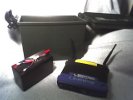|
Yes it does. What happens is when the device first starts it looks for another existing device advertising a network with the same name. If the name doesn't exist it will generate an ID locally (exact method depends on the software brining up the interface but it's suppsoe to be in a manner that no two devices will generate the same ID) and begin advertising the network. Every wifi beacon frame contains what is known as the TSF field, it is the wifi network time. It starts at 0 microseconds and goes up for each microsecond of time that passes on the wifi network. When you have two devices who couldn't see each other before that now can see each other the TSF is compared, the network with the higher TSF is assumed to be the longer lived network and the device will roll it's ID to match the identifier of the longer lived network thereby inheriting thr same ID. From these two methods EVERY device in the mesh will have the same IBSS/BSS identifier (sorry mislabeled it earlier) as it propagates through the network. If you logged into the remote bode you should see it claims the same address as well as the network it is joined to/advertising Literally every device in an ADHOC network will have this same association this is how the device knows when looking at wifi packets that the packet is meant for its network as names (BroadBandHamnet-20-v3) are a human nicety and are not actually used at the lower levels of hardware.
|
